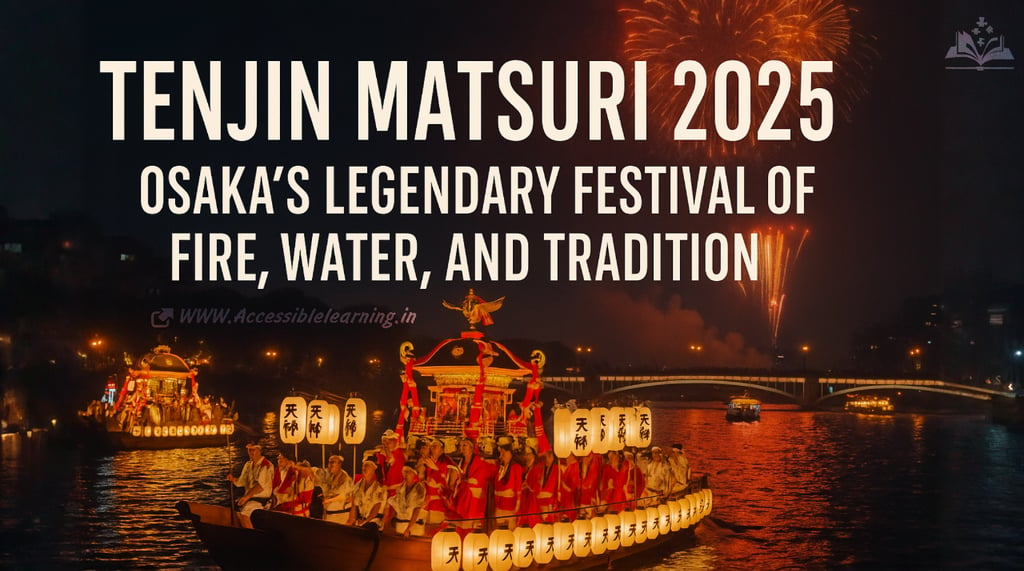
Tenjin Matsuri (Osaka): Japan’s Festival of Fire and Water
Experience Tenjin Matsuri 2025 in Osaka—a spectacular fire-and-water festival with ancient rituals, boat parades, fireworks, and cultural wonders.
CULTURE/TRADITIONEVENT/SPECIALJAPANCELEBRATION/FESTIVALSTRAVEL LIFE
Kim Shin
7/17/20256 min read


Osaka’s Tenjin Matsuri (天神祭) is one of the most spectacular and historic festivals in Japan. Often compared with Kyoto’s Gion Matsuri and Tokyo’s Kanda Matsuri, Tenjin Matsuri stands out for its fusion of fire, water, tradition, and energy. Held annually on July 24–25, it brings together vibrant processions, dynamic rituals, and grand fireworks—all centered around Sugawara no Michizane, the deity of learning and scholarship.
Whether you're a culture enthusiast, a first-time traveler to Japan, or a content creator looking for rich cultural visuals, Tenjin Matsuri delivers a blend of awe and authenticity.
The Origins: Honoring a Scholar-Turned-Deity
The festival dates back to 951 AD, making it over a millennium old. It is dedicated to Sugawara no Michizane, a scholar and politician who was deified as Tenjin, the Shinto god of learning and the arts. According to legend, when Michizane passed away, natural disasters struck, believed to be his angry spirit. To appease him, shrines were built, and festivals like Tenjin Matsuri were born.
The Osaka Tenmangu Shrine is the focal point of the festival and houses Michizane’s spirit.
Tenjin Matsuri Highlights: Two Days of Festive Magic
Day 1: July 24—The Eve (Yoimiya-sai)
Rituals Begin at Osaka Tenmangu Shrine
The festival starts with Shinto purification rituals, where priests pray for peace, good harvests, and success in academics.Land Procession Practice
Local participants rehearse the next day’s procession in traditional costumes.Cultural Performances
There are Noh plays, drum performances, and classical dance showcases around the shrine precincts.
Day 2: July 25—The Main Festival (Honmiya-sai)
This is when Osaka bursts into life.
Land Procession (Riku Togyo)
Begins in the afternoon from Osaka Tenmangu Shrine.
Over 3,000 participants dressed as samurai, nobles, shrine maidens, and lion dancers parade through central Osaka.
Includes mikoshi (portable shrines), music troupes, and traditional floats.
The atmosphere is charged with chants, bells, flutes, and drumbeats.
River Procession (Funatogyo) on the Okawa River
Starts around sunset.
The mikoshi are loaded onto decorated boats.
Around 100 boats, including ceremonial barges and party boats, float past, accompanied by music, dancing, and lanterns.
The whole river becomes a living light show.
Grand Fireworks Display
It begins around 7:30 PM and lasts over an hour.
Around 5,000 fireworks explode over the Okawa River, synchronized with the movement of boats and cheers of crowds.
Spiritual & Cultural Significance
Tenjin Matsuri isn’t just a spectacle; it reflects deep-rooted values:
Gratitude and Prayer—Locals pray to Tenjin for success in education and career.
Unity in Community—Neighborhoods come together to organize events, showcasing the strong social fabric of Osaka.
Tradition in Motion—The festival keeps centuries-old rituals alive while evolving with modern energy.
When Is Tenjin Matsuri 2025?
🗓 Dates
July 24 (Thursday), 2025—Opening Ceremony & Rituals
July 25 (Friday), 2025—Main Procession, Boat Parade & Fireworks
⏰ Key Timings
Land Procession: ~3:30 PM
Boat Procession: ~6:00 PM
Fireworks: ~7:30 PM–9:00 PM
Best Viewing Spots & Travel Tips
Fireworks & Boat Parade Viewing
Kawasaki Bridge Area
Closest to the actionon but very crowded. Arrive early.
Sakuranomiya Park
Family-friendly with good views and more space.
Temmabashi Station Area
Easy access and vibrant surroundings.
Access Tips
Nearest Stations:
Osaka Tenmangu Station (JR Tozai Line)
Minami-Morimachi Station (Subway Tanimachi Line)
Travel Smart:
Use a prepaid ICOCA card for smooth travel.
Trains and buses get extremely crowded, so plan to arrive early.
What to Bring
Portable fan or uchiwa (Japanese fan)
Lighclothing—– Osaka summers are hot and humid.
Water bottle, towel, and sunscreen
Camera with night mode (trust us, you’ll want it!)


Symbolism of Fire and Water in the Festival
The dual symbolism of fire and water in Tenjin Matsuri goes far beyond visual spectacle—it's rooted in Shinto cosmology:
Fire (Kagari-bi) represents purification and the divine, used to ward off evil and illuminate the spiritual path during the night.
Water (Mizu) signifies life, renewal, and transition, especially in the context of ferrying the kami (deity) across the Okawa River, symbolizing his temporary travel among the people.
Together, fire and water create a cleansing duality—the mikoshi is first paraded through the city (earth), then floated on the river (water), under fireworks (fire), before returning to the shrine (heaven/spiritual realm).
Osaka Tenmangu Shrine: The Epicenter
Most guides mention it briefly, but here’s what makes Osaka Tenmangu Shrine truly special:
Located in the Kita ward, it’s the second most prominent Tenmangu Shrine in Japan after Dazaifu Tenmangu (Fukuoka).
The current shrine building was reconstructed in 1845 after being destroyed multiple times by fire and war.
Locals affectionately call it “Tenma no Tenjin-san.”
It's open year-round and popular among students seeking blessings before exams.
During the festival, the usually serene grounds transform into a bustling spiritual and cultural carnival.
Behind-the-Scenes: Preparation and Community Involvement
Months before the actual event, a network of over 50 neighborhood groups, known as “danjiri” or “chōnaikai,” begins preparing floats, costumes, and logistics.
Volunteers, often from the same families across generations, handle:
Shrine cleaning
Boat decorating
Dance and musical rehearsals
Fundraising
This kind of multi-generational involvement is what keeps the festival authentic—it’s not just for show; it’s a living community heritage.
Rare Traditional Performances
Tenjin Matsuri is one of the few events where you can witness Hōsōgaku (court music) and Bugaku (classical imperial dance) outside Kyoto or Tokyo.
Rokudan no Shirabe (Six-step Harmony) is often performed—a musical piece that dates back to the Heian era.
Some boats feature Kagura dances—sacred performances originally meant to entertain the kami.
For those passionate about traditional Japanese arts, Tenjin Matsuri is a rare live showcase.
Costume Significance and Artistry
The attire seen during the land procession isn't randomly chosen. Every role has deep-rooted meaning:
Shishi-mai (Lion dancers): Ward off evil spirits with vigorous movement and mask-biting.
Chigo (sacred children): Boys aged 5–10 considered pure enough to accompany the kami.
Sarutahiko: A long-nosed deity of guidance often leads the parade.
Most of these costumes are custom-tailored using traditional methods—linen, brocade, and silk, hand-stitched by Osaka artisans.
Tenjin Matsuri in Modern Pop Culture
While deeply traditional, Tenjin Matsuri has had its moments in modern media:
Featured in Japanese TV dramas and anime that showcase Kansai life.
Used as a cinematic backdrop in movies for its vivid visuals and symbolic storytelling.
Local manga artists and illustrators often depict the fiery river scenes in their summer-themed works.
This blend of ancient and pop culture makes it an excellent storytelling asset for creatives.
Exclusive Festival Souvenirs
Unique, limited-edition souvenirs are sold only during the Tenjin Matsuri:
Omamori (charms) for academic success, often embroidered with the Tenmangu crest.
Miniature mikoshi keychains and fan-shaped talismans.
Festival-only sake blessed at the shrine.
Locals believe these items hold special energy because they are blessed during one of the holiest times of the year.
Festival Economy and Local Boost
The Tenjin Matsuri generates a significant economic surge for Osaka’s local businesses:
Increases footfall to food stalls, yukata rental shops, traditional music stores, and shrines.
Temporary work for boat operators, performers, vendors, and volunteers boosts seasonal employment.
Hotels around Umeda and Nakanoshima experience near 100% occupancy.
It’s a perfect case study of cultural tourism fused with economic sustainability.
Sustainability and Crowd Management
Given the growing concern for sustainability, the city has introduced
Eco-friendly boats with reduced engine emissions.
Reusable food trays and cups at stalls.
Crowd sensors and AI-enabled traffic guidance apps for managing over 1 million attendees efficiently.
It's a tech-meets-tradition approach that many modern festivals worldwide could learn from.
Digital Experience and Global Outreach
Since 2022, the organizers have embraced digital storytelling:
Live streaming of the fireworks and river procession for international audiences.
An official multilingual website with real-time updates and behind-the-scenes content.
AR filters and Instagram campaigns that let users “wear” Tenjin costumes digitally.
This makes Tenjin Matsuri not just a local event but a global celebration of Japanese heritage.
Suggested Itinerary for Tourists (2-Day Model)
📍Day 1: July 24
Morning: Visit Osaka Castle or Nakanoshima Art Museum
Afternoon: Attend opening rituals at Osaka Tenmangu
Evening: Enjoy cultural dances & local cuisine near the shrine
📍Day 2: July 25
Morning: Rent a yukata for an immersive experience
Afternoon: Watch the land procession (Temmabashi area is ideal)
Evening: Enjoy the boat procession & fireworks from Sakuranomiya Park
Night: Stroll through food stalls, collect souvenirs

What to Eat During the Festival
The streets around Tenmangu Shrine and riverbanks become a paradise for food lovers.
Popular festival foods include:
Takoyaki (octopus balls)
Okonomiyaki (savory pancakes)
Yakisoba (stir-fried noodles)
Kakigori (shaved ice)
Taiyaki (fish-shaped sweet pastry)
Vegetarian options may be limited, so plan ahead if you follow a specific diet.
Tips for First-Time Visitors
Respect the rituals: Be mindful around shrines and during ceremonial parts of the procession.
Go with a local guide if you’re new—they often share deeper stories and hidden viewing spots.
Document respectfully: Drones are not allowed, and flash photography is discouraged near shrines.
Fun Facts About Tenjin Matsuri
It’s often called the "Festival of Fire and Water" due to its symbolic elements.
The mikoshi never directly touch the ground or water—they are carefully carried.
Tenjin Matsuri costumes are handmade and passed down for generations.
Each participating boat is blessed by a Shinto priest before it joins the river procession.
Tenjin Matsuri is more than a festival—it's a living heartbeat of Osaka’s cultural soul. It blends divine reverence with festive joy, drawing over a million people each year. Whether you're captivated by the mysticism of Shinto rituals, the sensory overload of fireworks and floats, or the sheer warmth of the Osaka community—Tenjin Matsuri is unforgettable.
Subscribe To Our Newsletter
All © Copyright reserved by Accessible-Learning Hub
| Terms & Conditions
Knowledge is power. Learn with Us. 📚


